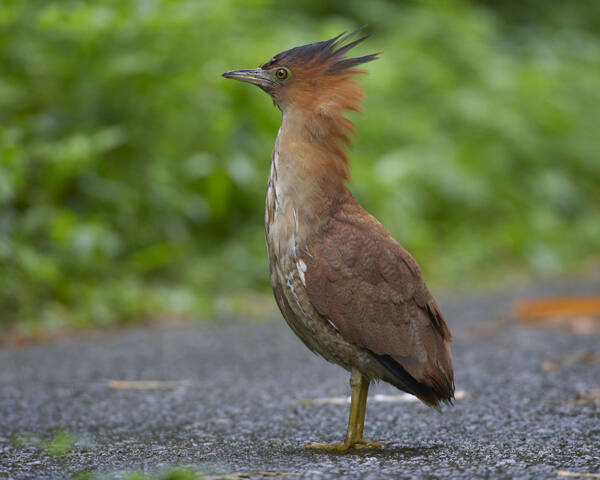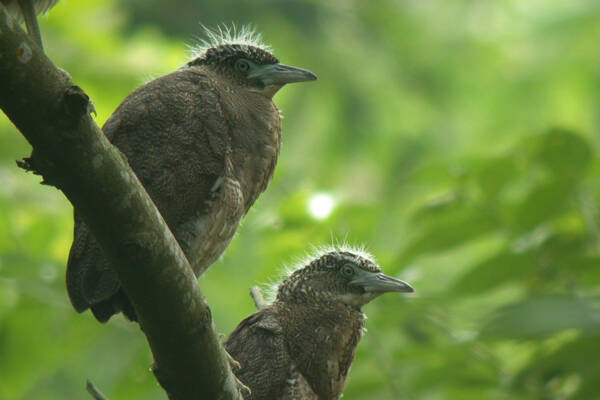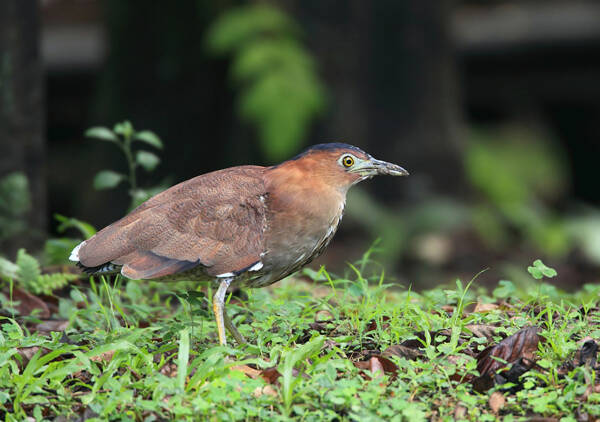Gorsachius melanolophus
IUCN
LCBasic Information
Scientific classification
- name:Gorsachius melanolophus
- Scientific Name:Gorsachius melanolophus,Malayan Night-heron,Black-crowned egret, Black-crowned bittern
- Outline:Wading birds
- Family:Ciconiiformes Ardeidae Bittern
Vital signs
- length:405-470mm
- Weight:About 600g
- lifetime:20years
Feature
It is small but stocky, with a dark reddish brown or black body.
Distribution and Habitat
In China, it is distributed in Zhejiang, Fujian, Hong Kong, Hainan Island, Guangxi, and Yunnan. Abroad, it is distributed in tropical and subtropical areas in southern and southeastern Asia.
It lives near valleys and streams in dense forests in mountainous areas, and is also found near low mountain swamps, rivers, and rice fields.
Appearance
The upper body, crown and neck of the adult bird are mainly reddish brown. The body shape and shape are similar to that of the chestnut bittern, but the crown and the crown feathers are black. The flight feathers are black with chestnut red end spots. The primary flight feathers have white end spots, which are more obvious when flying but difficult to observe when perched. The lower body is brownish yellow with white spots and vertical stripes, and the throat has dark brown vertical stripes. The iris is golden yellow, the beak is horny brown, and the feet are dark green.
Details
The black-crowned bittern, commonly known as the black-crowned bittern, lives in tropical and subtropical areas in southern and southeastern Asia. Its habitat and activity habits are basically similar to those of the Hainan bittern. In Xishuangbanna, Yunnan Province, it is mostly found alone in rice fields or ponds, feeding on fish, shrimp and aquatic insects. It is mostly found in rivers, streams, reservoirs and bamboo forests in mountainous forests. In Taiwan, it likes to move in mountain springs and streams in dense forests and on the ground in bamboo forests. It has been found in streams at 1,800 meters.

Nocturnal. Often active in the early morning, dusk and night, hiding in dense bushes, bamboo forests and reeds during the day. Shy and timid, extremely cautious in action, usually solitary. When disturbed, often stand still, with crest erected, staring around vigilantly. When flying, the wings flap faster and make sounds. Often make loud calls when active at night.
The main food is fish, shrimp and frogs. In the early stage of brooding, the food intake is less, and the food types are fish and shrimp. In the middle and late stages of brooding, in addition to fish and shrimp, there are more frogs, tadpoles, loaches and other aquatic insects.
The call of the black-capped bittern is a series of deep oo sounds, which are made every 1.5 seconds. It is usually called in the upper layer of the forest at dawn and dusk; it can also be called hoarse croaking and panting arh, arh, arh.
The breeding season is from May to June. They often nest in pairs. They usually build nests on tall trees beside rivers and streams in the primeval forest. The nests are mostly placed between branches in the canopy layer, hidden by dense canopy branches and leaves. The nest is dish-shaped, made of branches, and padded with some grass leaves. Each nest lays 4-5 eggs, which are white in color and broadly oval in shape, with almost the same shape at both ends. The size of the eggs is 44-49×36-40 mm, with an average of 46×37 mm, and weighs 11.5 (11.3-11.7) grams. The size of the nest is 15.74 cm × 16.63 cm in outer diameter, 9.23 cm × 9.23 cm in inner diameter, 4.05 cm in height, and 2.16 cm in depth. The incubation period is 15-18 days, and the brooding period is 25 days.

The number of black-crowned bitterns in China is extremely rare. Habitat destruction and water pollution are the main reasons for the reduction in the number of black-crowned bitterns.
Listed in the second level of China's "National Key Protected Wildlife List" (February 5, 2021).
In May 2022, the black-crowned bittern, a national second-level protected wild animal, was monitored on Qi'ao Island in Zhuhai. According to relevant experts, the black-crowned bittern photographed this time was the first record in Zhuhai. In the same month, the black-crowned bittern was observed for the first time in Xuzhou. In recent years, Guangdong has successively observed black-crowned bitterns in Shenzhen, Zhanjiang, Guangzhou and Zhuhai, but they are not common.

In October 2022, when the staff of the Luhe Nanwan Hongzhulin Provincial Nature Reserve sorted out the infrared camera monitoring data, they were surprised to find that they had captured the image of the black-crowned bittern, a national second-level key protected wild animal. This is also the first time that the activity image of the black-crowned bittern has been recorded in Shanwei.








